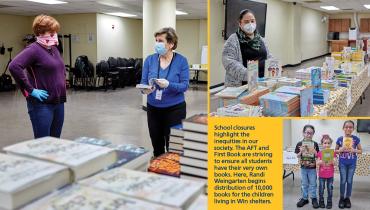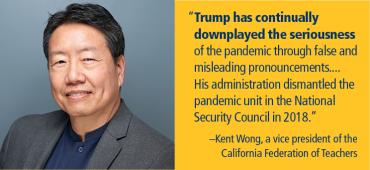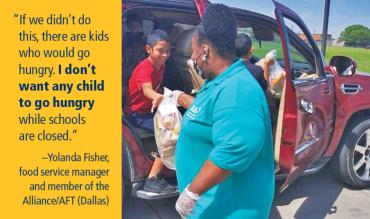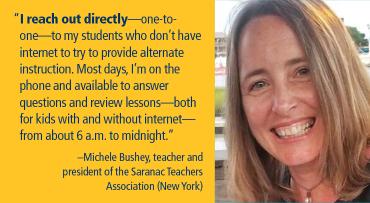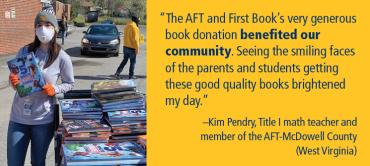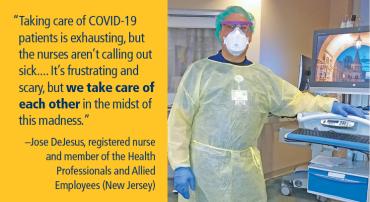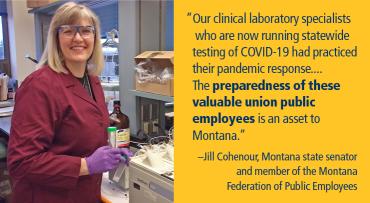The coronavirus pandemic and the ensuing economic downturn has been the worst crisis our country has faced since World War II. Fighting it requires a commitment to science and transparency, along with government intervention not seen since the Great Depression—and a spirit of common cause.
As someone who has dedicated my professional life, and much of my personal life, to building a stronger, more vibrant union movement, I know that our union has been built for this moment. It is the vehicle we can use to ensure our voice is heard and, with that, ensure a stronger democracy and a better life for all. As we face unprecedented challenges to our health, safety, and economic security, more and more people are seeing the true value of the union movement. Acting in unison, and as a broader community, we will overcome this pandemic and build a better America. How? Through service and caring, activism and voting.
As I write this, close to 100,000 people in the U.S. have died as a result of COVID-19 and nearly 40 million people have filed for unemployment. At the same time in these dark days, essential workers—including so many of our members—have been caring for, feeding, protecting, and educating America. The round-the-clock work of our healthcare professionals and public employees was obvious to all. Our food service workers fed families, not just children, with grab-and-go meals, and educators turned on a dime, as schools closed in mid-March, to engage their students remotely. This can-do attitude supported members across the country to jump into critical new roles—from school nurses administering COVID-19 tests in their communities to school bus drivers delivering meals to families. And our union was there every step of the way to provide support and devise solutions on the local, state, and national levels.
With each day of the pandemic, Americans have grown increasingly grateful for things we used to take for granted, like grocery workers, without whom we could not meet our most basic needs. Parents have a new appreciation for how complex and demanding teaching is, and for how teachers have been helping their children continue to learn, stay engaged, and stay safe inside during this uneasy time. And then there are our healthcare heroes: the nurses, EMTs, doctors, orderlies, respiratory techs, and other workers who put their health and lives at risk every time they report to the frontlines of this pandemic. Their jobs would be incredibly difficult even under the best circumstances, but the fact that so many have been forced to treat patients without adequate personal protective equipment or other safeguards is unconscionable—and the consequences have been deadly. We have lost far too many of our members to COVID-19. Some because the Trump administration downplayed the virus, refusing to prepare and protect the country before it was too late, and some because they did not have the protective gear they needed as they were protecting us. All of them, the souls we have lost, are people—not numbers. We must remember, honor, and mourn them.
We must also remember those who are with us, but are struggling. The children who can’t fully comprehend the pandemic but who miss going to school, playing with their friends, and having cookouts with relatives. The adults who live alone—especially those with conditions that put them at high risk—who are truly isolated. The teens who have missed out on coming-of-age rituals like attending prom, getting the lead role in the school play, scoring a goal, or hitting a home run. And the communities—families, students, and educators alike—who have looked forward to high school and college graduation ceremonies but whose hugs and high-fives will have to wait.
Thankfully, so many of us are learning how to be physically distant yet socially close. And we’re creating new ways to hold fast to our cherished traditions—such as the awe-inspiring graduation speech Barack Obama gave on May 16 as part of the Graduate Together initiative celebrating the high school class of 2020.
We’re also looking forward, building a new normal to safely live, learn, work, and socialize until we have a vaccine. Many states have flattened the curve and we are working with them to reopen in ways that are responsible. But some states, with Trump’s reckless prodding, are downplaying the virus. We will continue to resist their dangerous and misleading messages—and we’ll keep fighting for what’s needed to reopen safely: personal protective equipment, abundant testing, and virus containment. We do not have to choose between our physical health and our economic health. To transition from community-focused physical distancing and stay-in-place orders to responsible reopening, we need leaders who will ramp up the capacity to test, trace, and isolate each new case.
Leading by Listening
Until we have a vaccine and highly effective treatments, and until both are widely available, our priorities as a union are:
- the health, safety, and well-being of our members—especially our 200,000 healthcare workers and other members on the frontlines—and the communities in which we live and work;
- the short- and long-term economic supports working people need;
- the realization of new strategies—and funding to enact those strategies—for our public schools, colleges, businesses, and other institutions so we can protect people’s lives and livelihoods; and
- the integrity of elections and the health and safety of voters.
Together, we are accomplishing what is impossible to achieve alone. I will never ever forget the stories I have been hearing in the daily touches I have with leaders and members of my union—nurses, state employees, school food service personnel, and educators among them. I want to share some of what I’m hearing from the frontlines of this pandemic, from the alarming to the awe-inspiring.
There are bus drivers and food service workers developing plans to keep providing grab-and-go meals for families over the summer; teachers of English language learners creating new ways to build bonds with students and their families; and social workers, juvenile justice workers, and others who work in facilities like nursing homes and prisons, quietly reassuring the people they care for. Along with their worries, they share their hope and ingenuity and joy.
From the moment the first school closures were contemplated, I got urgent calls and emails from AFT members and leaders trying to figure out ways to feed students who rely on school meals so they wouldn’t go hungry. Here are just a few examples of the ways AFT members sprang into action for the students, families, and communities they love.
The Toledo (Ohio) Federation of Teachers is packing grab-and-go meals for students to last several days at a time. Tia Harris, a veteran school bus driver in Grants, N.M., is working with 20 other school bus drivers to deliver some 1,000 meals every day. Driving their normal routes, instead of picking up students, they drop off food. In Dallas, Yolanda Fisher and her colleagues go to work before dawn—preparing and packaging 700 breakfasts, 700 lunches, and 700 dinners that they distribute to students. And in Lee County in Florida, school food service workers are preparing and distributing up to 25,000 free grab-and-go meals every day, available to any child 18 or younger.
Millions of students have been learning remotely because of the amazing work of their teachers. In just a few days in March, 75,000 public school teachers in New York City alone converted their homes into remote learning centers. For United Federation of Teachers member Erica Wilde, an eighth-grade teacher at P.S. 99 in Brooklyn, this included using Google Translate to communicate with her students’ parents, who speak a wide range of languages—from Albanian to Uzbek. Sari Beth Rosenberg greeted the students in her virtual AP U.S. History classes with an upbeat song each day, then they launched into high-level discussions. But, Rosenberg says, “I will never be able to replicate the magic of teaching in a classroom from my laptop.”
Remote learning is not ideal, even under less stressful conditions. Teachers miss their kids, and many students have surprised themselves by wanting to go back to school. As we return to in-person learning, we will put our solution-driven unionism and ingenuity into addressing many of the learning-loss issues that have been raised.
And yet, educators across the country have been meeting the challenges of distance learning with ingenuity. Michael Shunney, an industrial technology teacher at West Warwick High School in Rhode Island, knew that healthcare and other essential workers in the state were in need of protective gear—and that his students were in need of a compelling opportunity to learn. On the state’s first day of distance learning, Shunney posed a question to his students: could they use the school’s 3D printers to make protective equipment? The students were up for the challenge and Shunney, with help from the school district and the West Warwick Teachers Alliance, got permission to take the school’s five industrial printers out of the school and distribute them to students. Using an open-source design, Shunney and four students already have produced hundreds of face shields, which are now protecting area nurses, doctors, EMTs, firefighters, and police officers. The fire chief said that, with protective equipment running low, the shields arrived “just in time.”
Lisa Donofrio teaches at the Fashion Institute of Technology. Even as she self-quarantined after being exposed to COVID-19 in her classroom, she remained focused on reworking classes and helping students complete their courses so their college careers are not derailed. Throughout the spring, Donofrio scheduled one-on-one virtual meetings and held regular class time. She tried to provide as much creative inspiration as possible, modeling a World War II strategy for her students: “Make do and mend.”
Even as we appreciate these innovative approaches to remote learning, we know that school closures have exposed many inequities in our country, including the digital divide. In the nation’s capital, where up to 40 percent of students lack a computer or internet access, the Washington Teachers’ Union partnered with local TV stations to air lessons aligned with district learning standards for different grade groups. And the digital divide is not just an urban problem. Michele Bushey teaches high school biology in Saranac, N.Y., where the mountainous terrain sharply limits internet access. The district’s shift to online learning didn’t work for students without internet, so Bushey spent hours each day calling students to provide alternate instruction, all while helping her daughter, who is in second grade, learn remotely. Bushey has been contacting legislators to advocate for expanded internet access. Without it, many parents in her community have to drive their children to parking lots outside buildings with Wi-Fi to do their homework. Even some teachers have had to resort to this.
We are building partnerships to ensure that students without internet access continue to learn, wonder, and explore, even as they stay safely inside. We’re prioritizing one of the most fundamental things families can do together—reading and inspiring a lifelong love of reading—so the AFT launched AFTBooks4Keeps. In partnership with First Book, a nonprofit through which the AFT has distributed more than 6 million books in recent years, AFTBooks4Keeps is focused on getting children books to ensure they can be engaged and stimulated in this very uncertain and isolating time through reading. To kick off AFTBooks4Keeps, the AFT donated 10,000 bilingual, multicultural, and social and emotional learning books from First Book to the more than 2,100 children living in Win shelters, the largest provider of family shelter and supportive housing in New York City.
Another low-tech, inclusive way we are reaching and helping as many people as possible is by phone. The AFT and the National PTA convened a telephone town hall in April about supporting our students and families. Among the 55,000 people on the call, most questions and comments were about coping with stress. Research shows that chronic stress may affect a child’s abilities related to self-regulation (including their emotions, attention, and behavior) and to learning. But research also shows that an essential factor for whether stress is tolerable or toxic is the presence of supportive relationships, like that of a caring parent or other adult. During the telephone town hall, experts in mental health, learning science, and psychology offered suggestions for alleviating children’s anxiety with routines, relationships and resilience. (Links to these resources are in the “Learn More” box, right.)
To help students sum up their learning this school year, the AFT brought together a cadre of preK–12 members in virtual teams to design Culminating Capstone Projects. These projects, organized by grade band, integrate standards-based content across subjects and are developmentally appropriate. Now available on the AFT’s sharemylesson.com, these projects engage students in honing the skills and knowledge they’ve acquired over the first seven months of classroom learning in innovative, meaningful ways. And they can also be deployed during a voluntary summer learning program or as a reentry into the next school year.
Honoring Workers
Many healthcare professionals have been redeploying to where they are needed most. In Connecticut, some school nurses are performing COVID-19 testing at drive-through testing centers. A longtime registered nurse with the New York State Department of Health volunteered to administer tests in New Rochelle, the first place in New York to see community spread of the virus, and then administered tests in other areas with outbreaks. “Seeing all these nurses volunteering,” she said, “it struck me that when everyone else is running away, nurses are there.”
Healthcare personnel are risking their lives every day not just because of the virus, but because of the Trump administration’s failure to plan and to use its power to increase supplies. Health Professionals and Allied Employees member Jose DeJesus, a registered nurse in New Jersey, said that hospital employees were being issued one single-use paper surgical mask and expected to make it last a whole week. Nurses at his hospital were being asked to save their single-use yellow gowns for possible laundering and reuse—gowns nurses routinely rip from their bodies to minimize exposure before throwing them away. While the Trump administration ignored this crisis—and even baselessly insinuating that healthcare workers were stealing—the AFT rallied. In the spring, the AFT purchased 500,000 N95 masks, 50,000 face shields, and 1,000,000 surgical masks for frontline workers like Jose DeJesus.
America’s health professionals are showing the compassion, competence, and commitment that are in short supply from the president, who claims absolute authority but shirks responsibility. Experts note that the Trump administration’s failure to acquire and distribute tests for COVID-19 resulted in far more cases and fatalities than in countries that made the necessary preparations. State employees—scientists and technicians who do important work behind the scenes for our collective health and safety every day—have rushed to fill the void. AFT members in Montana and New York have developed tests for COVID-19, and are working weekend shifts, early mornings, and late nights in state labs to turn around test results quickly so healthcare providers can plan treatment and stop the spread of the virus.
This pandemic has upended all our lives, but it has also put many things into perspective: Science is important. Government is important. Harnessing science and government for the good of the people is critical.
Everyday Americans—grocery workers at my neighborhood store; teachers making videos to show their students how much they are loved; the restaurants and small businesses trying to stay open and to keep their workers employed; nurses, orderlies, and intensive care doctors, like my kid sister—they are the best of America and the glue holding us together. And, when this crisis passes, we will properly honor and mourn those we have loved and lost.
Building a Better America
We all yearn to get back to normal. That means, in the absence of a vaccine, we must determine how to address both the health emergency and the economic catastrophe. It’s not an either-or choice; the health and safety of Americans go hand in hand with economic recovery. And we must “reopen America” better than we closed it.
While the president has shirked his responsibility, several governors—Republicans and Democrats—have stepped up. In one of our telephone town halls in April, we were joined by three of those frontline leaders: Michigan Gov. and AFT member Gretchen Whitmer, Illinois Gov. J.B. Pritzker, and New Mexico Gov. Michelle Lujan Grisham. They talked about two overriding questions: how to safely reopen public schools and the economy in general, and how to counter the financial threat the crisis poses to resources for education and other essential public services. All have consulted with our affiliates in their states to make sure working people are a priority of the recovery. The contrast between their leadership and Trump’s shows just how much elections matter. Partnering with these and other caring governors, we are making sure our members are being protected; essential services are being funded; and schools, colleges, public services, and healthcare systems are meeting the needs of those we serve.
Seeing that the Trump administration was not going to provide science-based guidance for reopening, we developed our own guide—and it’s now being used across the country. Unlike the president, who wasted several critical weeks pretending there was no real threat to the U.S., we were well prepared to develop a guide. We started focusing on the novel coronavirus in January, held our first press conference about it on February 4th, and immediately started responding. Our 20-page “Plan to Safely Reopen America’s Schools and Communities” (available at aft.org/reopen-schools) sprung from an intense collaboration of public health professionals, union leaders, and frontline workers—especially teachers and nurses. It sets forth specific, flexible strategies for what happens in the period between flattening the curve and truly eradicating the virus.
This crisis has laid bare every inequity of our country and as well as the disastrous consequences of cuts to the nation’s public health infrastructure. Think about it: the lack of paid sick leave for all workers, the prevalence of food insecurity, the gaping digital divide, and the unconscionable number of Americans who are uninsured or underinsured. Forty percent of Americans couldn’t put $400 together in an emergency pre-pandemic, and by mid-May, 39 percent of Americans who make less than $40,000 had lost work. Yet, states like Florida so defunded their governments that they can’t even get unemployment checks out to people.
We will need bold steps, through government action focused on the needs of working people, to repair the harm to people’s health, the economy, and our democracy. Economic stimulus measures must include funds for states and localities struggling to maintain basic government functions. And they must be designed to create a recovery shared by all Americans, especially the most vulnerable. That is why we are fighting week after week for the president and Congress to do their jobs and secure the federal funds needed to keep workers healthy, protected, and employed and to keep local and state governments, the Postal Service, and colleges and public schools functioning. This pandemic crushed state revenues as people had to stay home; Trump and Senate Majority Leader Mitch McConnell need to work with Democrats to save states, schools, and small businesses—just as 84 percent of Americans want them to do, according to a poll in May.
This gets to the heart of who we are as a union—we care, we fight, and we show up. I have never been more proud of our members. Our members are helpers and heroes who amaze me and give me hope during these difficult days. Together, we will get through this.

